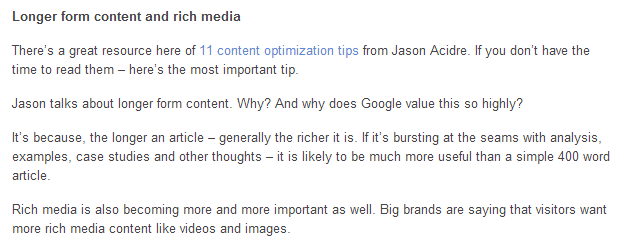As you must know, search engine optimization is usually divided into two different categories:
- On-page search engine optimization or, as more commonly known, on-page SEO.
- Off-page search engine optimization aka off-page SEO.
If you want to learn more about on-page SEO, read this blog post.
In this article, we discuss about off-page SEO and its most important aspect, i.e., backlinks. This blog post is written for absolute beginners. So if you have never learned about backlinks (or link-building), this is the perfect place for you to start with.
Moreover, if you already have some knowledge about backlinks, this article also introduces a few intermediate concepts that you might find useful, e.g., the differences between poor-quality backlinks and high-quality backlinks, Google penalties for bad backlinks, editorial and contextual backlinks, etc.
Let’s start from the top.
What is a Backlink?

When another blogger creates a link back to your website or a particular web page, she is directing her traffic to your website because she believes that your web page and its contents add value to her users. That’s a vote of confidence and an acknowledgment of the credibility and authority of your website.
As you can guess, you cannot directly affect this. It has to be a natural process.
If you have a highly informative website with lots of valuable contents, other people would automatically start creating backlinks to your site.
Search engines like Google would see those links as votes of confidence and as recognition of your site’s high quality. It would assume that if other bloggers and website owners believe that your content is worthy to be linked to, it would only be appropriate to show it to more and more people when they search for topics around it.
As a result, Google promotes your web page up in the rankings, so more and more people could find it in the search engine results pages (SERPs).
How to Build Backlinks?
First of all, it is important to understand that most backlinks should come naturally. As mentioned earlier, based on the quality of the information your website has, people would create backlinks to it automatically and without any intervention from your side.
In the meanwhile, you can also help facilitate that process. We won’t go too much into the details of link-building, but here are two basic ideas for building backlinks:
- When you publish a great piece of content or informative guide, it is a good idea to manually reach out to influencers in your industry and let them know about it. If they see fit, they might create a backlink to it.
- Do guest-blogging and publish your blog posts on other authoritative websites. At the end of each guest post, the writer can create an editorial backlink to her own website.
Two Different Types of Backlinks
Broadly speaking, we can categorize backlinks into two different categories:
- Editorial backlinks
- Contextual backlinks
Editorial backlinks are the ones that guest-bloggers get within their author bio. Here is an example of an editorial backlink.
In the above example, you can see an editorial backlink to youngprepro.com.
Editorial backlinks are relatively easy to get. For instance, if you manage to get a guest-post publish, you’d automatically get an editorial backlink.
However, they are somewhat less powerful than contextual backlinks.
Contextual backlinks are created within the content body. They appear more natural and, hence, are more powerful. However, it is important that you are not forcing contextual backlinks and only adding them if they fit there perfectly and add a lot of value to the user’s reading and content-consumption experience.
Following is an example of a contextual backlink. As you can see, the following backlink appears naturally within the content.
Backlinks and Search Engine Penalties
Although the process of backlinks is supposed to be a natural one, it is a common practice for search engine optimizers to manually build backlinks.
However, Google keeps a close eye on how SEOs do that.
If they do not follow the best practices, Google intervenes and, instead of improving their site’s position in the search engine results pages, it actually penalizes the website and demotes the rankings.
Therefore, search engine optimizers need to be careful with how exactly they are building backlinks.
Again, we won’t go into too much details, but let’s discuss a few things that SEOs need to be aware of when building backlinks:
- The backlinks that you create should come from relevant blogs and websites. For instance, if you have a blog on gardening tips, it would be weird if you are getting most of your backlinks from, say, a casino related website.
- The backlink profile should be a natural one (a mixture of high-quality backlinks and normal backlinks).
- The anchor texts should have diversification.
- You must never buy backlinks. Otherwise, Google will definitely penalize you.
The Google Penguin algorithm specifically targets websites with poor-quality, artificial, and irrelevant backlinks. Upon identification, it penalizes those websites and damages their search engine rankings.
Final Words
Google never explicitly tells the weightage of its search engine ranking factors. However, it has been confirmed that, out of a list of over 200 ranking factors, backlinks are in the top three search engine ranking factors for Google.
A website without too many backlinks can’t rise higher in the SERPs. It becomes too difficult. You have to have a natural yet strong backlink profile to achieve those higher search engine spots.
Following are some more articles related to backlinks and link-building, if you are interested in reading more about this topic:
- A Beginner’s Guide to Analyzing Your Competitor’s Backlinks and Keywords
- A Step-by-Step Guide to Generating Backlinks with the Broken Link Method
- A Guide to Creating Content that Attracts Powerful Backlinks
- Backlink Advice: 5 Backlink Myths You Should Completely Ignore in 2017
- 3 Types of Backlinks: The Good, the Bad, and the Worst
https://www.writersincharge.com/blog/
